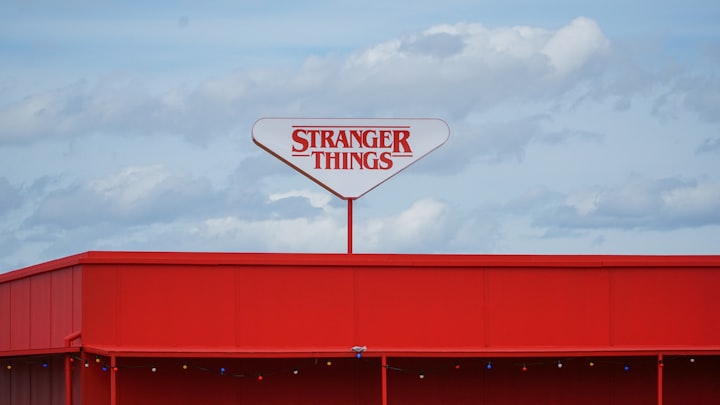21st Century Popular Culture
Singapore, Stranger Things, & Heroes

Market Culture and Singapore's Hyperreality

In 2017, my parents and I traveled to Singapore. Everywhere I looked, I was amazed by the city’s hyperreality. The amount of advertising was astronomical compared to any other place I’d ever visited, which added to the sense of artificiality and illusion. Inside every bus, subway cart, gondola lift, bathroom stall, on every park bench and billboard was some form of advertisement. Now, Brisbane isn’t far behind. We can’t listen to the radio, access online streaming services, or open our phones or laptops without exposing ourselves to marketing. Furthermore, advertising now appears on social media platforms, search engines, and apps and programs that we have already downloaded, asking us to pay more money to a brand we already support.
Every few people I speak to seem to be studying marketing, or work as marketing consultants or managers. Social media management has become a whole industry in itself in the last decade. We now live in a society of market culture. In his book The Rise of Market Culture Professor William Reddy writes that market culture is ‘a set of (wrong) perceptions’ (Reddy, 1984, p. 1). This idea, though subjective, rejects capitalism. The perceptions Reddy refers to may be ‘wrong’ in his view, but not necessarily for another person (Reddy, 1984, p. 1). The market system was and continues to be dictated by politics, which is why each consumer of popular culture sees a unique combination of advertising and marketing; companies such as Google and Amazon use suggestions and automated advertisements for each Internet and social media user. We as consumers both engage with this marketed content and form an obstacle to the development of a free market (Bruegel, 2002, p. 67).
The argument could also be made that we are already participants of a free market through social media. I support this Marxist approach to social media and market culture (Beverungen, Böhm, Land, 2015, pp. 473-489). The idea of choosing what content to put out and consume, rather than being surrounded by propaganda and tailored recommendations, is much more appealing to me. This form of marketing also doubles as self-expression, though at times can be used for self-promotion. If social media could be used solely to incite positive change, people may be more inclined to share honest messages that evoke emotional reactions rather than financial return, the latter of which does not directly enrich people emotionally or intellectually.
Stranger Things

Stranger Things is Netflix’s most-streamed series (The Verge, 2019). The Netflix original could be named a modern pop culture phenomenon, with almost fourteen million Instagram followers and sixty-four million streams on Netflix.
I believe the series’s popularity stems from its broad appeal. The characters range from children to adults, all of whom exhibit a variety of interests and behavioural patterns. A range of genres is recognisable in each installment, including horror, science fiction, and drama. One aspect of the series that makes it attractive to almost all viewers is its humour within and beyond the diegesis.
The Los Angeles Times recently published an article about viewer interactivity and engagement. ‘Netflix, after all, isn’t simply a place to binge watch. One can view it as a detailed personality engine …’ (Martens, 2019). This refers to the recommendations Netflix curates for its users. The idea behind this article is about how viewers need to feel like they are involved in popular culture to continue consuming it. Consumers’ investment and interest in a particular series, film, or even streaming service must be earned.
The series is very meme-able, which seems to be important in today’s online culture. Stranger Things and Netflix’s social media uses memes to market its series and films as well as their stars. MTV is also known for this tactic, as well as various magazines and accounts of individual series and films. This approach to marketing is very successful because it engages viewers by encouraging them to create their own memes and artworks, as well as participate in quizzes, interactive videos and polls, and attend events around the world. Previously, marketing for popular culture was limited to announcements, trailers, and posters, but in today’s touch-and-go society, viewers expect—and need—more.
Consumers can no longer sit still and watch a series or film—they need to be doing something, tapping and swiping on their phones, getting the instant gratification that we feel entitled to (Trautman, 2018). Stranger Things responds to this consumer need. Viewing this through a Fiskean lens, the illusion of being listened to is pleasant because it makes me feel involved in a series I like. However, I know that my individual voice is not truly heard. I am only a consumer of mass culture broader than the Stranger Things franchise. The content released by Stranger Things becomes part of the capitalist system, but Fiske would argue that consumers may manipulate popular culture and make it their own, which is what Stranger Things does (Routledge, 2003).
Heroes

In August, 2008, my Grade 4 brought a newspaper clipping into class. The photograph was familiar to me, even though I’d never seen it before; as well as being the daughter of a professional swimming coach, I was in the early stages of my career in competitive swimming. In the newspaper photograph were four young Australian women in ankle-length swimsuits, gold medals around their necks. The title of the article was something along the lines of Our Heroes.
Our teacher asked us whether we agreed with this title or not. To prompt us, he asked us to name some heroes. Most of the other children named policemen and firefighters. A few said Superman. I was unsure of my stance.
My classmates’ personal views may have belonged to the Birmingham School, but their interpretation of the media’s representation of sport could have been an unknowing agreement with Fiske’s view that consumers of mass culture react to media and manipulate it how they see fit.
In Grade 10 English, my class studied a book called The Invisible Hero. Our teacher asked us to name a hero. My classmates named celebrities, actresses, athletes, and performers such as Beyoncé, Kim Kardashian, Walt Disney, Bruce Lee, and Ellen DeGeneres. I said that I didn’t believe in heroes, but in heroic acts. At the time, I was not conscious of popular culture theory. I thought only of my own views, but now I realise that, though I was not conforming with ideals that my classmates adhered to, I was conforming to other theorist’s ideas.
In retrospect, I am fascinated that as children, my peers had named paramedics and other emergency response personnel as their heroes, because their careers are considered noble. However, as young adults, their heroes became celebrities. Our desire to conform to a capitalist society became stronger than our desire to display an awareness of admirable deeds and noble pursuits. My peers started out as believers in the Fiskean theory, then migrated to assimilate with capitalism.
I view heroes through an existential and psychoanalytic lens, which is a trademark of the Frankfurt School. Is a hero someone whose thoughts are noble, or whose feelings and physical actions are admirable? I don’t find any definition of heroism to be adequate, so I feel that for me the Frankfurt School’s frame of analysis is most suitable to defining and viewing heroism.
References
The Verge. 2019. Netflix says Stranger Things’ third season is record-breaking, but what does that mean? https://www.theverge.com/2019/10/16/20918044/stranger-things-break-record-third-season-netflix-earnings-report-bird-box
Los Angeles Times; Martens. 2019. Why streaming services need to embrace game design — and give users the illusion of ownership. https://www.latimes.com/entertainment-arts/tv/story/2019-10-11/streaming-wars-apple-tv-plus-disney-plus-user-look-and-feel-next-wave
The Hollywood Reporter; Porter. 2019. ‘Stranger Things 3’ Sets Netflix Viewing Record for Series. https://www.hollywoodreporter.com/live-feed/stranger-things-sets-netflix-viewing-record-series-1248225
Kaltura; Trautman, 2018. Interactive Video: Why It Matters, and Why It Doesn’t Always Work. https://corp.kaltura.com/blog/interactive-video-what-it-is-why-it-matters-and-why-it-doesnt-always-work/
Reddy, M., 1984. The Rise of Market Culture, pp. 1, 22, 222
Bruegel, M., 2002. The Rise of the Market Society in the Hudson Valley, 1780-1860, pp. 67
Beverungen, A., Böhm, S., & Land, C., 2015. ‘Free Labour, Social Media, Management: Challenging Marxist Organization Studies’. Organization Studies, 36 (4), pp. 473–489.
Routledge, 2003. Understanding Popular Culture, pp. 112-116
About the Creator
Svetlana Sterlin
Svetlana Sterlin is based in Brisbane, Australia, where she writes prose, poetry, and screenplays. The founding editor of swim meet lit mag, she also edits with Voiceworks.
More from Svetlana: https://linktr.ee/svetlanasterlin






Comments
There are no comments for this story
Be the first to respond and start the conversation.